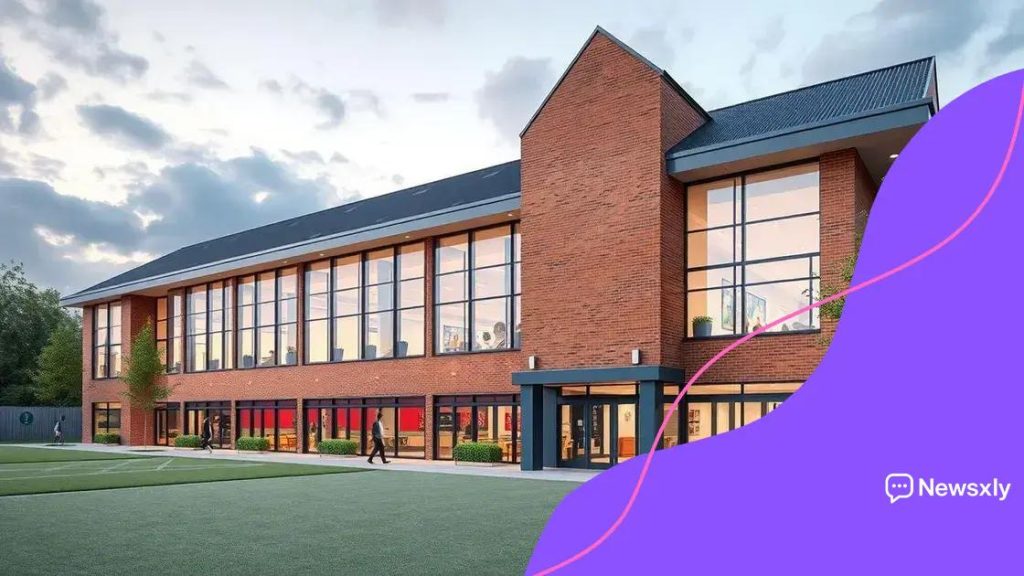UK school building upgrades: transforming learning environments

Upgrading UK school buildings enhances learning environments, improves student outcomes, and promotes sustainability through innovative design and technology integration.
When we talk about uk school building upgrades, it’s not just about new paint and furniture. These enhancements can profoundly impact students’ educational experiences. Are you curious how these upgrades influence learning?
the importance of upgrading school buildings
Upgrading school buildings is essential for creating a positive learning environment. These upgrades not only enhance aesthetics but also play a crucial role in student well-being and success. A well-maintained school can provide a welcoming space that inspires and motivates students.
Benefits of Modernizing School Infrastructure
When schools invest in upgrades, they can see significant improvements in various aspects of education. Modern schools typically include flexible learning spaces, improved technology integration, and safer facilities. These features help students focus better and engage more in their studies.
- Better air quality and natural light improve concentration.
- Advanced technology supports innovative teaching methods.
- Flexible classrooms adapt to different learning styles.
Furthermore, upgrading reduces maintenance costs over time. New systems often consume less energy and require fewer repairs, allowing schools to allocate resources more effectively. This financial efficiency directly impacts the educational experience.
Creating Safe and Inclusive Spaces
Safety is another critical reason for upgrading school facilities. Modern upgrades include advanced security systems and accessibility improvements, ensuring that every student feels safe and welcome. Enhancing ramps, doorways, and communal areas fosters inclusiveness among all students.
Schools also benefit from engaging outdoor spaces, contributing to physical health and mental wellness. Playgrounds, gardens, and recreational areas offer students a chance to relax and socialize, which is vital for their development.
key features of modern school infrastructure
Modern school infrastructure embodies several key features that promote an effective learning environment. By focusing on functionality, comfort, and technology, schools can create spaces that enhance student experiences.
Flexible Learning Spaces
One significant aspect of modern school infrastructure is the design of flexible learning spaces. These areas can be adapted for various teaching methods and activities. Classrooms with movable furniture allow teachers to reconfigure the space based on specific lessons or student needs.
- Collaborative zones encourage teamwork among students.
- Quiet areas support concentration and independent work.
- Outdoor classrooms enhance experiential learning opportunities.
Moreover, open layouts foster communication and engagement. Students can easily interact with peers and educators, making learning more dynamic and participatory.
Technology Integration
Technology plays a pivotal role in modern schools. Classrooms equipped with smartboards, tablets, and reliable Wi-Fi connect students to a wealth of resources. This integration not only enhances instruction but also prepares students for a technology-driven world.
Interactive learning platforms allow for customization of lessons and assessments. Teachers can monitor progress in real time, offering tailored support where needed. This personalized approach helps cater to each student’s unique learning style, ensuring they thrive.
In addition, schools that invest in technology create a secure environment. Advanced security systems, such as surveillance cameras and access controls, protect students and staff, fostering peace of mind within the school community.
funding and resources for school upgrades

Funding and resources for school upgrades are essential for transforming educational environments. Schools often face challenges when it comes to securing the necessary funds for renovations and improvements. However, there are numerous avenues they can explore to obtain financial support.
Government Grants and Programs
Many governments offer grants specifically designed for school upgrades. These grants can cover a portion of renovation costs, allowing schools to enhance their facilities. Schools can also tap into state programs aimed at improving educational infrastructure, providing additional financial avenues for upgrades.
- Federal funding programs often support modernizing outdated facilities.
- State initiatives may focus on specific needs, like energy efficiency.
- Local governments might offer grants for community-based projects.
Engaging with these programs can greatly alleviate financial burdens, making improvements more achievable.
Private Donations and Partnerships
Another valuable resource comes from private donations and partnerships with businesses. Many companies are eager to contribute to their local schools, often viewing it as a community investment. Establishing connections with local businesses can lead to sponsorships that help fund specific projects.
Community fundraising events are also an effective way to gather resources for school upgrades. Parents, alumni, and local residents can come together to support school initiatives, generating funds while also fostering a stronger community bond.
Furthermore, educational foundations and nonprofit organizations sometimes offer funding opportunities tailored to specific needs, such as technology integration or infrastructure improvements.
sustainable practices in school renovations
Sustainable practices in school renovations are essential for creating environmentally friendly and cost-effective learning environments. By focusing on sustainability, schools can reduce their ecological footprint and save money in the long run.
Energy Efficiency Improvements
One key aspect of sustainable renovations is enhancing energy efficiency. Installing energy-efficient windows and insulation can significantly reduce heating and cooling costs. Schools can also benefit from upgrading to LED lighting, which consumes less energy and lasts longer.
- Renewable energy sources, like solar panels, can provide clean energy.
- Smart thermostats optimize energy use based on occupancy.
- Energy-efficient appliances contribute to lower utility bills.
These improvements not only help the environment but also create a comfortable space for students and staff alike.
Water Conservation Strategies
Implementing water conservation strategies is another vital element of sustainable school renovations. Installing low-flow fixtures, such as faucets and toilets, reduces water usage significantly. Schools can also collect rainwater for irrigation, promoting a more sustainable approach to landscaping.
In addition to conserving water, schools can create green spaces using native plants that require less maintenance and irrigation. These outdoor areas provide students with natural environments that enhance learning and well-being.
By adopting these sustainable practices, schools not only benefit the planet but also teach students the importance of environmental stewardship. Engaging students in sustainability initiatives encourages them to become responsible citizens and advocates for a healthier planet.
success stories: schools that transformed with upgrades
Success stories of schools that transformed with upgrades highlight the positive impact of investment in education. Many schools have embraced changes that not only improve their facilities but also enhance student achievement and community involvement.
Case Study: Green Valley High School
Green Valley High School underwent a remarkable transformation by prioritizing energy efficiency and technology upgrades. The school installed solar panels, which cut energy costs by 40%. This financial relief allowed the school to redirect funds towards new computer labs and advanced educational programs.
- Students now have access to cutting-edge technology for learning.
- Teachers can implement interactive lessons that captivate students.
- Environmental stewardship has become a core part of the curriculum.
As a result, student test scores improved significantly, and the community praises the school for its dedication to sustainability.
Example: Oakwood Elementary’s Renovation
Another inspiring example is Oakwood Elementary, which focused on creating a safe and inclusive environment. The school renovated its facilities to include accessible pathways and recreational areas. They added ramps and improved lighting, ensuring that all students can navigate the school safely.
This focus on inclusivity not only boosted student morale but also strengthened community ties. Parents became more involved, and local businesses supported fundraising events to enhance school programs.
Teachers reported higher levels of student engagement, boosting attendance and participation in extracurricular activities. Oakwood’s commitment to fostering a welcoming environment serves as a model for other schools looking to make similar upgrades.
FAQ – Frequently Asked Questions about School Upgrades
Why are upgrades to school buildings important?
Upgrades improve learning environments, enhance student engagement, and can lead to better academic performance.
What funding options are available for school renovations?
Schools can explore government grants, private donations, and community fundraising to secure funds for upgrades.
How can schools implement sustainable practices during renovations?
Schools can focus on energy-efficient designs, water conservation strategies, and using environmentally friendly materials.
What are some successful examples of schools that have upgraded their facilities?
Schools like Green Valley High and Oakwood Elementary have transformed their environments through energy efficiency improvements and inclusive designs.





